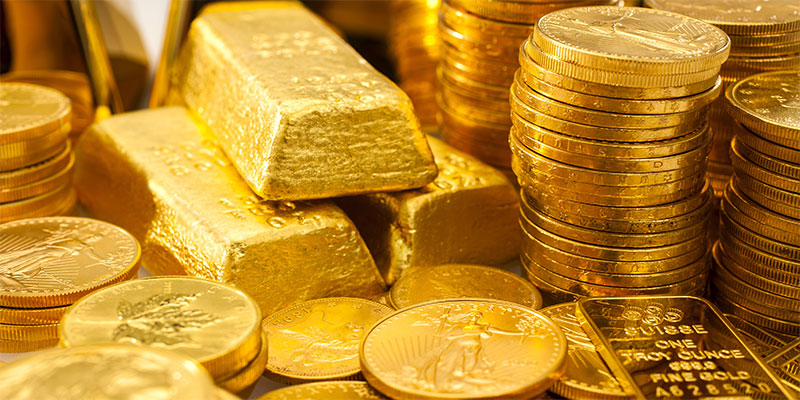This week, gold touched $3,500/oz for the first time ever.
It’s up 30% this year and 200% over the last five years.
In fact, gold has gained 620% over the last 20 years, beating the S&P 500’s gain (including dividends) of 580%.
Many smart investors and traders say gold is heading for $5,000 in a hurry. We’ll see.
So… how much gold do you own?
If the answer is zero, I (Dan) aim to change that with this essay. I’ll show you why everyone should have at least a 5% allocation to gold, up to 10% or even as high as 15%.
To be clear, I dislike writing about gold. Like Warren Buffett said, it “just sits there.” As someone who started a disruption research firm, I’d much rather write about exciting companies and the technologies they’re unleashing.
But every time I’ve put off buying gold, I’ve regretted it. Maybe this essay will help you avoid similar regrets. After all, $10,000 bought you six ounces of gold five years ago. Today, it buys you less than three.
How long until $10,000 only buys one ounce of gold?
- Confession of a former gold bug.
I started my career in 2008, working in the World Financial Center a few blocks from Wall Street. My first clients included Bear Stearns, Lehman Brothers, and Merrill Lynch, which all collapsed within months.
So I forgive my younger self for being overly skeptical of stocks and the financial system in general, and very into gold.
It took me until 2013 to realize gold is not, by itself, a good investment. But gold is a great investment as part of a larger portfolio. When mixed into a portfolio of stocks and bonds, gold works wonders to both reduce volatility and increase overall long-term returns.
It works that way because gold has a low or negative correlation with stocks, bonds, and other financial assets. So when their prices go down, gold prices often hold strong or rise.
For proof, look at the worst three markets of this century so far:
Financial crisis: By March 2009, the S&P 500 had dropped 57% from its peak. Gold’s maximum decline was 30%. By the time the market bottomed, gold had already recovered to near all-time highs. It then doubled by the time the S&P 500 clawed its way back to breakeven.
Dot-com bust: While the S&P 500 got cut in half and the Nasdaq lost 80% of its value, gold quietly gained 15%.
COVID: Similar story. By the time the stock market recovered to pre-crash levels, gold was up 30%.
- Today, gold is rocketing while everything else struggles.
The herky-jerky tariff announcements have caused economic uncertainty to spike to levels not seen since COVID.
Both the S&P 500 and Nasdaq have slipped into bear markets. Most bonds are down too. Even cash—as measured by the US Dollar Index (DXY)—is down 8% since January.
Meanwhile, gold is up 30%. Four times more money poured into gold ETFs in the last three months than in all of 2024.
The rush into gold isn’t just retail investors buying a few coins. Institutions, sovereign wealth funds, and central banks are shifting billions. China’s central bank has already bought more gold this year than in all of 2024 (60 tons, to be exact, or about $6.5 billion worth at today’s prices).
If they’re accumulating billions in gold, shouldn’t you own at least a little bit?
Gold has recorded new all-time highs in 12 of the last 13 weeks.
- Gold’s superpower is that its value is independent of any other factor.
Unlike stocks, gold doesn’t require the economy to keep humming or trade to keep freely flowing to rise in value.
Unlike government bonds, gold doesn’t require politicians to act with long-term prudence to hold its value.
And unlike the US dollar, which has lost 86% of its purchasing power in the last 50 years, gold has always appreciated over the long term.
Gold’s value is independent. It doesn’t require anyone to keep promises. It’s the only financial asset like this. The only possible exception is bitcoin (BTC), but that’s a topic for another day.
If you’re bored with the idea of gold, I get it. Gold doesn’t pay dividends or compound your wealth through earnings.
It won’t be disrupting anyone. But it’s also unlikely to ever be disrupted, a claim no company can make.
- Buy some gold, forget about it, and get on with your life.
You don’t have to become a gold bug or cheer for the implosion of the financial system. You can own gold just in case. Chances are you’ll never need it. But if you do, you’ll be happy you have it.
Besides, there’s not much opportunity cost to owning gold as part of a larger portfolio. As I mentioned, an allocation of 5%–10% in gold smoothes out your portfolio returns.
How should you buy gold? Broadly, you’ve got two choices:
Gold ETFs like the SPDR Gold Trust (GLD) are “paper” gold. They track the gold price. They’re better than nothing. But when you own GLD, you don’t own any metal. If you’re trading in and out of gold, that’s fine. But if you’re holding long term as part of a balanced portfolio, why not own the real thing?
Plus, paper gold doesn’t always show up when you need it most. In 2008, some gold ETFs halted redemptions.
Physical gold is always the #1 choice. The kind you can hold in your hand and that can’t be hacked, frozen, or obfuscated by third parties. Just a timeless asset that’s held its value for 2,000+ years.
In my opinion, the best way to buy and store physical gold is through Hard Assets Alliance. I have personally opened an account there. You can buy and sell physical gold through them easily.
They can also store your physical gold for you, so you don’t have to worry about it getting stolen. Or, if you wish, they can deliver your gold to your home at any time.
If you’re interested in owning gold, RiskHedge readers can currently get 12 months of free storage with Hard Assets Alliance.
And don’t put it off.
Regards,
Dan Steinhart
Publisher, RiskHedge



